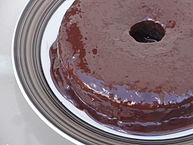Ganache
 Chocolate ganache being poured into a bowl | |
| Type | Chocolate |
|---|---|
| Place of origin | France |
| Main ingredients | Dark semi-sweet chocolate, cream |
Ganache (/ɡəˈnæʃ/ or /ɡəˈnɑːʃ/;[1] French: [ɡanaʃ]) is a glaze, icing, sauce, or filling for pastries, made from chocolate and cream.[2]
In the broad sense of the term, ganache is an emulsion between (melted) solid chocolate (which is made with cocoa butter, the fat phase) and a water-based ingredient, which can be cream, milk or fruit pulp.[3] Depending on the ratio of cocoa butter and water in the finished product, ganache can be either semi-solid or liquid at room temperature, which allows its usage in a wide diversity of desserts and confectionery items.[4]
Preparation
[edit]Ganache is a chocolate preparation, normally made by heating equal parts by weight of cream and chopped chocolate, warming the cream first, then pouring it over the chocolate. The mixture is then typically left to rest for a short period (between 3 and 10 minutes generally, dependent on volume) before it is stirred or blended until smooth, with liqueurs or extracts added if desired. The resting period allows the hot cream to increase the temperature of the bowl and its contents. If one were to blend immediately this would introduce air reducing the temperature and preventing the chocolate from melting consistently. Butter is generally added to give the ganache a shiny appearance and smooth texture.
Adding corn syrup also gives it a shiny color and is used to sweeten the ganache without the crystallization side effect that comes from other sugars. Depending on the kind of chocolate used, for what purpose the ganache is intended, and the temperature at which it will be served, the ratio of chocolate to cream is varied to obtain the desired consistency. Typically, two parts chocolate to one part cream are used for filling cakes or as a base for making chocolate truffles, while one to one is commonly used as a glaze. If using white chocolate, a ratio of 3 parts chocolate to 1 part cream is standard. Heavy whipping cream is generally preferred, to make a creamier, thicker ganache. This pairs well with dark chocolate between 60 and 82%. If the chocolate should seize while being mixed with the warm cream, adding tablespoon by tablespoon of hot water to the mixture can remedy the problem.
Cooled ganache can be whipped to increase volume and spread as icing to cover a cake. It becomes thicker as it cools. Ganache is also poured into a mold or terrine while warm, and allowed to set or cool. Once cool, it can be removed from the mold and sliced similarly to pâté.
History
[edit]It is said that ganache was originally invented in the 1850s in France during an accident in which water was poured over chocolate.[5] Ganache or crème ganache was originally a kind of chocolate truffle introduced by the Paris playwright-turned-confectioner Paul Siraudin, and first documented in 1869.[6] Siraudin named the sweet after a popular Vaudeville comedy debuted in that year by his contemporary Victorien Sardou called Les Ganaches ("The Chumps").[7][8]
Ganache-like sweets have probably been made earlier. An example being the German confectioner Jordan & Timaeus, who sold chocolate combining cocoa paste, sugar and fresh milk in 1839 in Dresden.[9]
Gallery
[edit]-
Ganache being poured atop a cake
-
Peanut butter fudge covered in ganache
-
A chocolate cake with ganache frosting
-
A video of making ganache
-
Shiny appearance of ganache
See also
[edit]- Enrobing — a chocolate coating process
- Chocolate tempering
References
[edit]- ^ "Ganache". Merriam-Webster Online, accessed 27 July 2023
- ^ Rombauer, Irma S.; Marion Rombauer Becker; Ethan Becker (2006). Joy of Cooking. New York: Scribner. p. 795. ISBN 0-7432-4626-8. Retrieved 27 July 2023.
- ^ Zeiher, Pierre; Truchelut, Jean-Michel (2020). La pâtisserie de référence. Editions BPI. p. 301. ISBN 978-2-85708-905-6.
- ^ Schloss, Andrew; Joachim, David (May 2019). "La science de la ganache au chocolat". Fine Cooking. Retrieved 13 June 2024.
- ^ Saglio, Aurelie; Bourgeay, Julien; Socrate, Romain; Canette, Alexis; Cuvelier, Gerard (October 2018). "Understanding the structure of ganache: Link between composition and texture". International Journal of Gastronomy and Food Science. 13: 29–37. doi:10.1016/j.ijgfs.2018.05.003. S2CID 139756329. Retrieved 27 July 2023.
- ^ 'Jeanne', "Correspondance: Jeanne à Florence", Journal des Demoiselles 37:27 (1869)
- ^ Oxford English Dictionary 3rd edition online, 2015, s.v.
- ^ Larousse Gastronomique (Third English language ed.). Hamlyn. 2009. p. 488. ISBN 978-0-600-62042-6.
- ^ Mayer, Susann (January 2021). "Rekonstruktion der ersten Milchschokolade gelungen". Technische Universität Dresden. Retrieved 16 June 2023.
Die Kakaomasse so fein zu mahlen wie heute war z.B. damals nicht möglich. Milchpulver gab es damals nicht, so wurde Flüssigmilch verwendet. „Bei den ersten Versuchen hatte die Masse eher die Textur eines Kaubonbons. Am Ende sind wir bei 60 Prozent Kakao, 30 Prozent Zucker und 10 Prozent Milch angelangt", erzählt Schneider.
[For example, it was not possible to grind the cocoa mass as finely as it is today. There was no powdered milk back then, so liquid milk was used. “In the first attempts, the mass had more the texture of a chewy candy. In the end, we ended up with 60 percent cocoa, 30 percent sugar and 10 percent milk," says Schneider.]
External links
[edit] Media related to Ganache at Wikimedia Commons
Media related to Ganache at Wikimedia Commons




